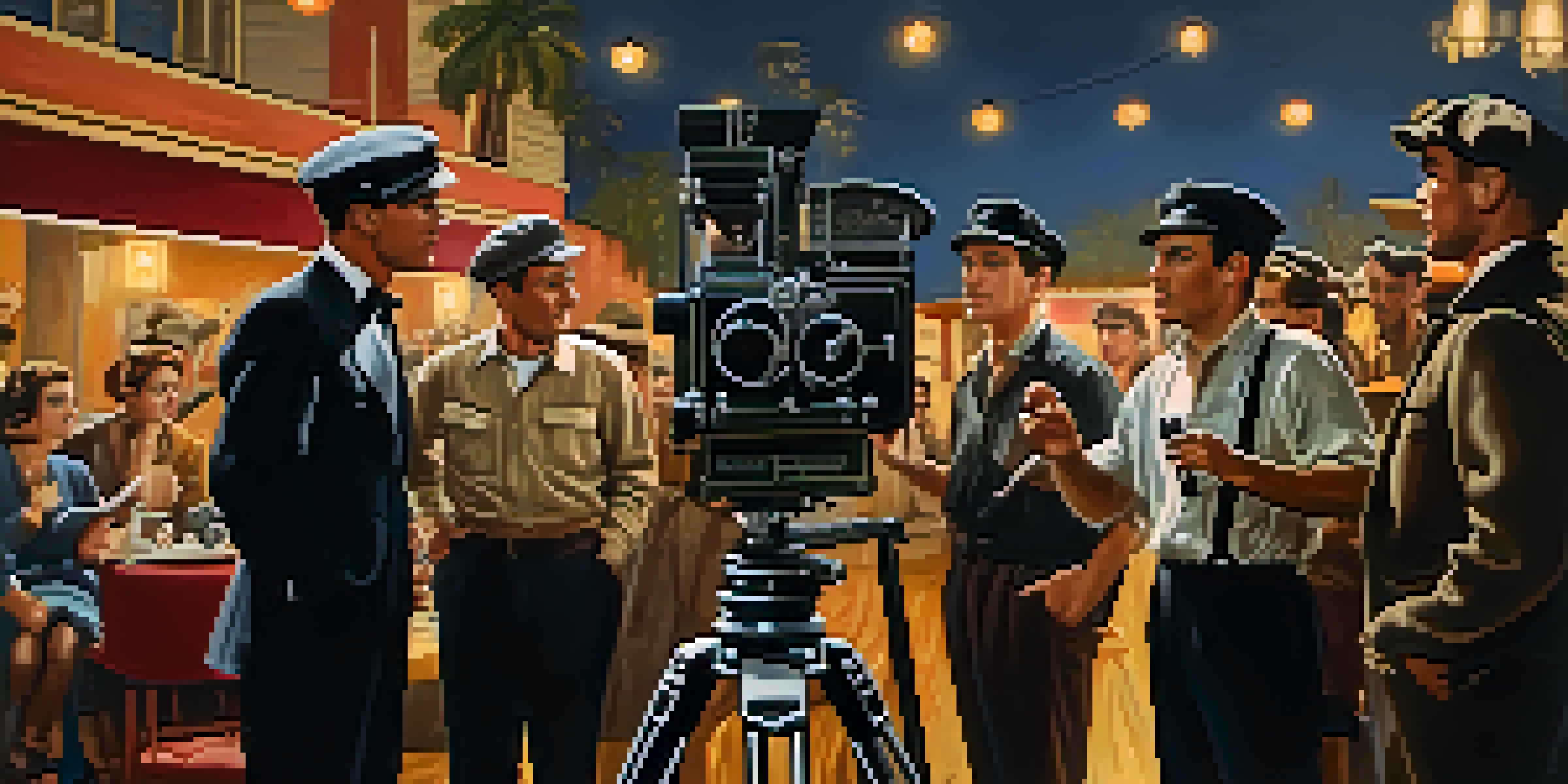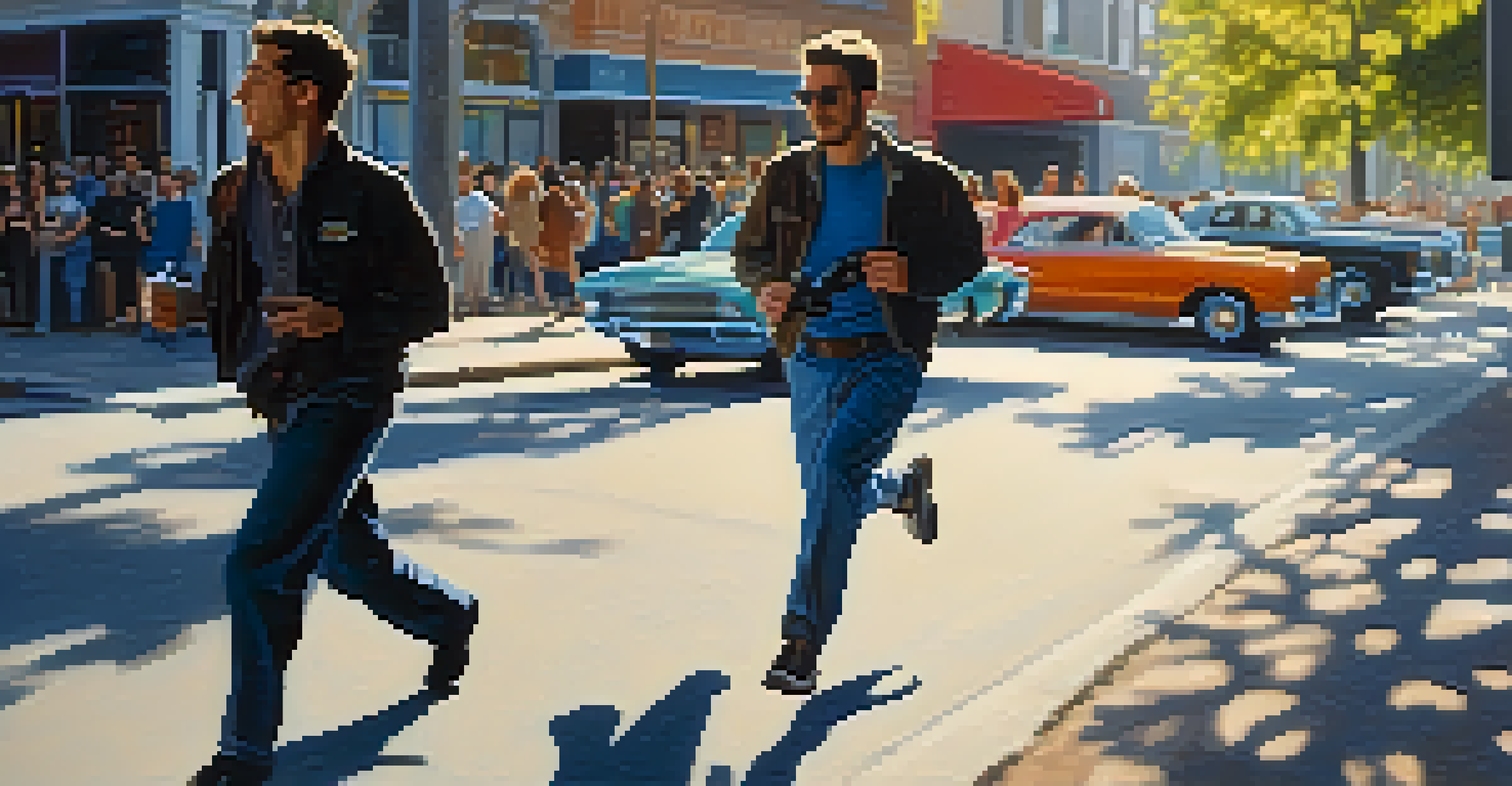The Evolution of Cinematic Techniques from Classic Hollywood

The Golden Age: Foundations of Cinematic Techniques
The Golden Age of Hollywood, spanning from the 1920s to the 1960s, laid the groundwork for modern filmmaking. Iconic directors like Alfred Hitchcock and Orson Welles revolutionized visual storytelling through innovative camera angles and editing techniques. For instance, Welles' use of deep focus in 'Citizen Kane' allowed audiences to engage with multiple layers of action simultaneously, changing how narratives were constructed.
The medium is the message.
During this era, the studio system dominated, creating a formulaic approach to filmmaking. Films were often shot on set, using elaborate backdrops and controlled lighting to achieve a polished look. This method may seem restrictive today, but it provided a consistent quality, allowing filmmakers to focus on storytelling without the unpredictability of location shoots.
While some may view this period as limited by its conventions, it actually fostered creativity within those boundaries. Directors learned to manipulate the resources at their disposal, leading to groundbreaking innovations that would shape the future of cinema.
Technological Advancements: The Shift Begins
The 1960s and 70s marked a pivotal shift in filmmaking, primarily due to technological advancements. The introduction of lightweight cameras and portable sound equipment allowed filmmakers to venture beyond the confines of studio sets. This newfound freedom facilitated a more documentary-style approach, as seen in films like 'Easy Rider' and 'The French Connection.'

This period also saw the rise of color cinematography, which transformed the visual landscape of films. Directors began to use color not just for aesthetics but as a storytelling device, enhancing emotions and themes. For example, the vibrant colors in 'The Wizard of Oz' significantly contrasted the sepia tones of Kansas, symbolizing the protagonist's journey into a fantastical world.
Golden Age: Foundations of Film
The Golden Age of Hollywood established essential cinematic techniques and storytelling methods that continue to influence filmmakers today.
Moreover, the experimentation with editing styles began to take root during this time. Directors played with jump cuts and non-linear storytelling, a practice that would become more prevalent in the years to come, breaking traditional narrative structures and engaging audiences in new ways.
New Wave Movements: Breaking Conventions
The rise of New Wave cinema in the late 1950s and 1960s brought a fresh perspective to filmmaking. Directors like François Truffaut and Jean-Luc Godard challenged established norms, emphasizing personal expression and authenticity. This rejection of the traditional narrative structure allowed filmmakers to explore complex themes and characters in a more relatable manner.
Film is a very powerful medium, and it can easily be used for all kinds of things, from propaganda to social change.
Filmmakers in the New Wave movement often employed innovative techniques such as handheld camera work and on-location shooting. These choices created a sense of immediacy and intimacy that resonated with audiences. For instance, Godard's 'Breathless' featured jump cuts that not only broke the flow of time but also reflected the restless energy of youth culture.
As a result, these movements not only influenced aesthetics but also shifted the industry’s focus toward independent cinema. This laid the groundwork for future filmmakers to explore personal and social narratives, ultimately reshaping the cinematic landscape.
The Rise of CGI: A New Dimension in Film
As technology advanced, the film industry embraced computer-generated imagery (CGI) in the 1990s, revolutionizing visual storytelling. Movies like 'Jurassic Park' showcased the incredible potential of CGI, allowing filmmakers to create lifelike creatures that captivated audiences. This marked a turning point, as filmmakers could now visualize concepts previously thought impossible.
CGI not only enhanced fantasy and sci-fi genres but also opened doors for more realistic depictions in various film styles. For instance, the seamless integration of CGI in historical dramas like 'Gladiator' added depth to battle scenes, elevating the overall experience. This technology allowed filmmakers to craft intricate worlds that engaged viewers on multiple sensory levels.
Tech Advances Shape Filmmaking
Technological advancements in the 1960s and beyond transformed filmmaking, allowing for more creative expression and innovative storytelling techniques.
However, the rise of CGI also sparked debates about the balance between practical effects and digital enhancements. While CGI offers boundless possibilities, many filmmakers still value the tactile authenticity of practical effects, leading to a blend of techniques that enrich modern storytelling.
The Impact of Streaming: Accessibility and Innovation
The emergence of streaming platforms in the 2010s reshaped how audiences consume films, leading to a democratization of filmmaking. With platforms like Netflix and Hulu, independent filmmakers found new avenues to showcase their work, often bypassing traditional studio systems. This shift has resulted in a diverse array of stories and voices that were previously underrepresented.
Streaming services also encourage experimentation, allowing filmmakers to take creative risks without the pressure of box office expectations. Series like 'Black Mirror' exemplify this trend, blending film and television storytelling in innovative ways. Such platforms have revolutionized narrative formats, leading to episodic storytelling that mirrors cinematic techniques.
Despite the challenges posed by streaming, such as the oversaturation of content, it has undeniably fostered a rich environment for creativity. As filmmakers adapt to this new landscape, we can expect a continual evolution of cinematic techniques that push boundaries and redefine traditional storytelling.
Cinematic Techniques in the Age of Social Media
As social media platforms proliferated in the 2010s, they became crucial in shaping cinematic techniques and storytelling. Filmmakers began to leverage platforms like Instagram and TikTok to engage audiences directly, often using short-form content to explore narratives in new ways. This shift has encouraged creative storytelling that often blurs the line between film and social media.
The emphasis on visual storytelling on these platforms has also influenced how films are marketed. Trailers and teasers are crafted to be shareable, focusing on eye-catching visuals and compelling hooks to capture attention quickly. This has led to the trend of creating cinematic experiences that cater to shorter attention spans, a reflection of changing audience behaviors.
Streaming Revolutionizes Access
The rise of streaming platforms has democratized filmmaking, enabling diverse voices and experimental narratives to flourish outside traditional studio systems.
Moreover, filmmakers are now using social media to foster community engagement, often involving fans in the creative process. This participatory approach not only builds a loyal audience base but also enriches the storytelling experience, making it feel more collaborative and inclusive.
Looking Ahead: The Future of Cinematic Techniques
As we look to the future, the evolution of cinematic techniques continues to be driven by technological advancements and changing audience expectations. Virtual reality (VR) and augmented reality (AR) are emerging as exciting frontiers for filmmakers, offering immersive experiences that redefine how stories are told. These technologies invite viewers to engage actively with narratives, creating a sense of presence that traditional cinema cannot replicate.
Furthermore, the integration of artificial intelligence (AI) in filmmaking is beginning to reshape production processes. From scriptwriting to editing, AI tools are streamlining workflows and allowing filmmakers to focus more on creativity than logistics. This could lead to a new wave of storytelling that blends human creativity with technological innovation.

Ultimately, the future of cinematic techniques will likely reflect a synthesis of past innovations and future possibilities. As filmmakers continue to explore and experiment, we can anticipate a rich tapestry of stories that challenge norms, engage audiences, and push the boundaries of what cinema can achieve.